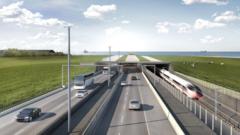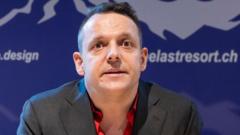A monumental construction project is underway to build the world's longest pre-fabricated road and rail tunnel, the Fehmarnbelt tunnel, which will stretch 18 kilometers under the Baltic Sea. The tunnel aims to enhance travel efficiency and integration between Scandinavia and the rest of Europe.
**Groundbreaking Baltic Sea Tunnel Set to Revolutionize Travel Between Denmark and Germany**

**Groundbreaking Baltic Sea Tunnel Set to Revolutionize Travel Between Denmark and Germany**
A new tunnel under the Baltic Sea promises a transformative boost to transportation links between Denmark and Germany, cutting travel times and enhancing inter-European connectivity.
Located at Lolland Island's northern coast in Denmark, the construction site spans a vast area, featuring both a factory and harbor that specialize in manufacturing the tunnel's sizable segments, termed “elements.” Each element measures 217 meters long and 42 meters wide, reinforced with steel and encased in concrete. Unlike traditional underwater tunnels that tend to drill through bedrock beneath the seabed, this submerged method involves linking together 90 individual elements as one would assemble Lego bricks.
With a total investment of approximately €7.4 billion ($8.1 billion), the primary funding has been sourced from Denmark, complemented by €1.3 billion from the European Commission. The project promises to reshape the regional infrastructure landscape is expected to decrease the travel journey between Rødbyhavn in Denmark and Puttgarten in Germany to just 10 minutes by car and 7 minutes by train, a significant reduction compared to the current 45-minute ferry ride.
Once fully operational by 2029, the tunnel will also reduce the travel time between Copenhagen and Hamburg from five hours to just 2.5 hours, facilitating a greener pathway for both passengers and freight. "It’s not just about connecting Denmark with Germany, but also linking Scandinavia to central Europe," expresses Henrik Vincentsen, CEO of Femern A/S, the state-owned company managing the project.
The infrastructure project was initially met with opposition, particularly from ferry operators and conservation groups concerned about its potential ecological impact. However, legal challenges have been overcome, allowing construction to commence while ensuring efforts are made to minimize environmental repercussions.
The project is not only aimed at improving connectivity but also at enhancing economic prospects for the region, potentially benefiting businesses and stimulating employment in Lolland, one of Denmark's less prosperous areas. As they await the completion of this ambitious venture, the local community expresses optimism about the positive changes it could bring.
With a total investment of approximately €7.4 billion ($8.1 billion), the primary funding has been sourced from Denmark, complemented by €1.3 billion from the European Commission. The project promises to reshape the regional infrastructure landscape is expected to decrease the travel journey between Rødbyhavn in Denmark and Puttgarten in Germany to just 10 minutes by car and 7 minutes by train, a significant reduction compared to the current 45-minute ferry ride.
Once fully operational by 2029, the tunnel will also reduce the travel time between Copenhagen and Hamburg from five hours to just 2.5 hours, facilitating a greener pathway for both passengers and freight. "It’s not just about connecting Denmark with Germany, but also linking Scandinavia to central Europe," expresses Henrik Vincentsen, CEO of Femern A/S, the state-owned company managing the project.
The infrastructure project was initially met with opposition, particularly from ferry operators and conservation groups concerned about its potential ecological impact. However, legal challenges have been overcome, allowing construction to commence while ensuring efforts are made to minimize environmental repercussions.
The project is not only aimed at improving connectivity but also at enhancing economic prospects for the region, potentially benefiting businesses and stimulating employment in Lolland, one of Denmark's less prosperous areas. As they await the completion of this ambitious venture, the local community expresses optimism about the positive changes it could bring.





















